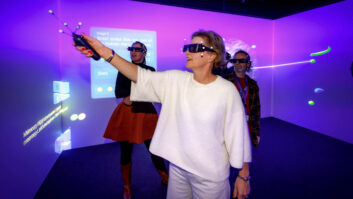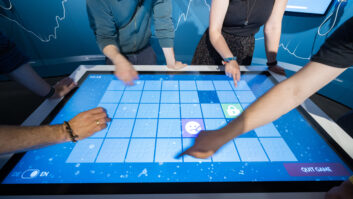
As we move through the first year of a new decade, technological advancements within the AV sector and beyond continue to move at a phenomenal pace, while areas such as sustainability and environmental issues are top of the agenda for all businesses, in all industries – and rightly so.
These are the biggest challenges, opportunities and considerations facing the AV sector, in my opinion…
Augmented/Virtual/Mixed Reality (XR)
Personally, for the market I am working in, I find Augmented Reality far more interesting than Virtual Reality (at least until someone invents a completely virtual video conferencing solution!).
The short-term impact of AR will be relatively small in my opinion, until it becomes more accepted in wider society. Once it has gained acceptance and the technology is a bit more mature I can imagine it will quickly become more important, for example, a remote meeting attendee being mapped into an empty chair in a physical meeting room, Virtual 3D visualisation of designs for new products that can be discussed together in a project team meeting and so on. These developments will obviously need audio systems that support the illusion with directional microphones and audio replay capability.
The Internet of Things (IoT)
The Internet of Things is a very wide subject but looking at it from an AV perspective we have already witnessed development in this area, particularly with monitoring system performance and fault detection. There are a number of systems, such as Shure’s SystemOn which continually monitor connected devices and automatically alert support staff if there is a problem.
As we deploy more technology in our workspaces this capability will become crucial as we cannot rely on the old model of an end user noticing a problem and calling for assistance.
The capabilities of this type of system being used by integrators and their customers provides an efficient, reliable performance for the end user, allowing the industry to move from a supply and repair model to a managed service, or even AV as a service model.
You may also be interested in:
In the near future, I would expect to see systems that self-configure by detecting what other equipment is connected to them to form a complete system, greatly easing deployment, particularly in global projects. IoT also opens up the capability of other possibilities using Machine Learning and Big Data.
Immersive Audio
Immersive Audio is a prerequisite of all immersive environments – there is little point in deploying a fantastic 3D theme park video experience if the audio doesn’t support the illusion! To a great extent the technology already exists to provide the immersive experience required, but I would expect the techniques to become easier and more flexible in the future.
Big Data
Once we have all of our disparate pieces of technology talking to each other via the IOT we will build up a massive amount of data – the question is then – what do we do with it? Possibilities include developing real information about usage patterns to inform product and system development.
With the availability of Big Data, Shure could potentially obtain and analyse information on how long Axient Digital ADX transmitters are in operation between recharges as they are used in various projects and environments globally, which could have a direct impact on the development of battery capacity in all future products.
Machine Learning
By combining IoT and Big Data with machine learning capacity we can start to experience real benefits for the end user.
For example, imagine a situation where a large number of rooms have been deployed and over a period of time faults have been detected and resolved. All of this data is centrally held and machine learning systems are in place, this may enable fault prediction on a statistical basis to become a reality, and therefore systems components could be replaced before they fail.
We could also start to see self-healing systems start to appear where a failed component has its firmware updated automatically, or one connected room is used to support another room with a failed component.
Green/Environmental Considerations
The AV industry is at the very forefront of technological advancements which are having a direct impact on the global environment – something which we must continue to invest in.
By deploying the most effective audio solution within remote and virtual meetings, companies reduce the need to physically send employees across the world, therefore cutting down on carbon emissions. Efficient, smarter systems recognise when to turn themselves off, helping with the direct consumption of resources, along with more reliable and upgradable equipment that doesn’t need to be replaced so often that will also have a direct impact on waste and the environment as a whole.
The User Experience
The user experience is where we succeed or fail. The closer we can get to a completely intuitive or automatic user interface, the easier it is to gain acceptance of a new technology or installed systems.
Manufacturing and producing products of the highest quality and reliability offers better ROI to the customer along with a more enjoyable and engaging experience as their staff become more comfortable interacting with their colleagues via the technology.
To use an audio example, if all parties on a call cannot hear each other clearly the meeting can be stressful and frustrating and any future meetings by that group could potentially not be scheduled remotely.
Conversely, if good quality and unobtrusive technology such as Microflex Advance MXA910 Ceiling Array Microphone with IntelliMix is used the participants can focus and discuss the issues of that particular meeting, rather than having to discuss issues with the technology in the room.
With any AV system and all future technological developments within the conferencing sector, the gold standard must be that the end user should not be thinking about the equipment at all, just their own interactions within that meeting, any more than a group of people meeting together face to face are focused on the carpet within the meeting room.






